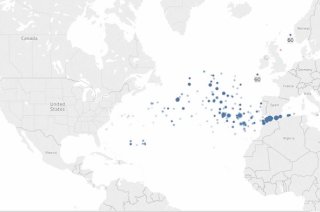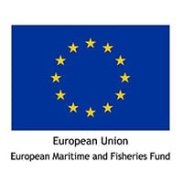
News
European eel larval migration animation from the Sargasso Sea to Europe: Why do some stay behind?
European eel Anguilla anguilla migrates 5 to 6,000 km from the European continent to the Sargasso Sea to reproduce (Schmidt, 1923). This animation based on length and distribution of the offspring shows how leptochephalus larvae of European eel pop up in the Sargasso spawning grounds at a size of ~3 mm. European eel was identified as having 112-119 myomeres and was therewith distinguished from the American eel A. rostrata with 103-111 myomeres (Smith, 1989). The growing European eel larvae also appear close to the coasts of the USA and islands such as Cuba. The larvae grow steadily up to a size of ~40 mm which they reach in September (Miller et al., 2015), and at this size they appear to leave the Sargasso. They migrate towards the European continent which they reach at a size of ~80 mm. Upon arrival at the continental shelf they metamorphose into small transparent eels called glass eels. Glass eels stay in the brackish tributaries or migrate upstream the fresh waters and start their growth stage as pigmented yellow eels. However, there is a group of larvae that does not migrate towards Europe and that stays behind in the Sargasso Sea. These individuals grow further over 90 mm. What will happen with these larvae? Will they grow even further and will they metamorphose? Will they migrate later and if so, when? A year later together with a new generation of eels? Or will they stay, and will they die?
- Unfortunately, your cookie settings do not allow videos to be displayed. - check your settings
This animation was made with Tableau (https://www.tableau.com) and based on data from the ICES data portal of eggs and larvae (http://eggsandlarvae.ices.dk/map.aspx).
Please cite as: Van Mil, J.G.M. and Palstra, A.P. (2018) European eel larval migration animation from the Sargasso Sea to Europe: Why do some stay behind? Retrieved from http://www.eelric.eu.
Acknowledgements
This publication was supported by the DUPAN foundation; the Dutch Ministry of Economic Affairs and the European Union, European Maritime and Fisheries Fund. The authors thank our partners of the international EELRIC consortium (www.eelric.eu).

References
- Miller, M.J.,Bonhommeau, S., Munk, P., Castonguay, M., Hanel, R., McCleave, J.D. (2015) A century of research on the larval distributions of the Atlantic eels: a re-examination of the data. Biol. Rev., 90, 1035–1064.
- Schmidt, J. (1923) Breeding places and migration of the eel. Nature 111, 51–54.
- Smith, D. G. (1989). Family Anguillidae: Leptocephali. In Fishes of the Western North Atlantic (ed. E. B. Böhlke), pp. 898–899. Sears Foundation for Marine Research, New Haven.


